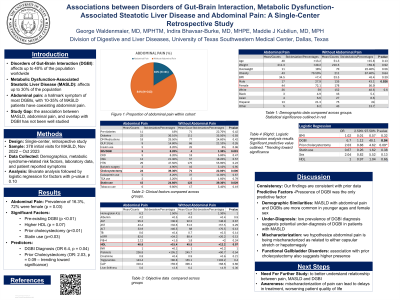Sunday Poster Session
Category: Liver
P1232 - Associations Between Disorders of Gut-Brain Interaction, Metabolic Dysfunction-Associated Steatotic Liver Disease, and Abdominal Pain: A Single-Center Retrospective Study
Sunday, October 27, 2024
3:30 PM - 7:00 PM ET
Location: Exhibit Hall E

Has Audio

George Waldenmaier, MD, MPH
University of Texas Southwestern
Dallas, TX
Presenting Author(s)
George Waldenmaier, MD, MPH1, Indira Bhavsar-Burke, MD, MHPE2, Maddie J. Kubiliun, MD, MPH3
1University of Texas Southwestern, Dallas, TX; 2University of Texas Southwestern Medical Center, Dallas, TX; 3UT Southwestern Medical Center, Dallas, TX
Introduction: Disorders of Gut-Brain Interaction (DGBI) are a highly prevalent group of conditions, affecting up to 40% of the population worldwide. Similarly, Metabolic Dysfunction-Associated Steatotic Liver Disease (MASLD) is the most common form of chronic liver disease, affecting up to 30% of the population. Abdominal pain is a hallmark symptom of most DGBIs, and prior data suggests that 10-35% of MASLD patients have coexisting abdominal pain. Despite this high prevalence, the association between MASLD, abdominal pain, and overlap with DGBI has not been well studied.
Methods: We conducted a single-center, retrospective study of 378 initial visits for patients diagnosed with MASLD from November 2022 to October 2023. Basic demographics data and relevant clinical information including metabolic syndrome-related risk factors, laboratory data, and patient reported symptoms were collected and analyzed according to presence or absence of abdominal pain. Factors identified with a p-value ≤ 0.10 on bivariate analysis were then included in logistic regression analysis to assess potential predictors of abdominal pain in patients with MASLD.
Results: At the time of initial visit, 16% of patients endorsed abdominal pain; of these patients, 72% were female (p = 0.03). There were no other significant demographic differences. Only 2.4% of patients had a prior diagnosis of DGBI. Statistically significant factors included a pre-existing diagnosis of DGBI (p < 0.01), higher HDL (p = 0.07), prior cholecystectomy (p < 0.01), and statin use (p = 0.03). Only prior diagnosis of DGBI was found to be a significant predictor of symptoms (OR: 6.7; p = 0.04), with prior cholecystectomy trending toward significance (OR: 2.03; p = 0.09).
Discussion: Our findings are consistent with the rates of abdominal pain in MASLD suggested in prior data. Prescence of DGBI was the only predictive factor for abdominal pain in patients with MASLD. There are notable similarities in demographics data between patients with abdominal pain and MASLD and those with DGBIs (e.g female sex and younger age). The low prevalence of DGBI diagnosis in our cohort compared to the general population suggests potential under-diagnosis of DGBI in patients with MASLD. The association to prior cholecystectomy also suggests a higher presence of functional gallbladder disorders. Our findings highlight the need for further study to characterize the interplay between abdominal pain, MASLD, and DGBI.
Disclosures:
George Waldenmaier, MD, MPH1, Indira Bhavsar-Burke, MD, MHPE2, Maddie J. Kubiliun, MD, MPH3. P1232 - Associations Between Disorders of Gut-Brain Interaction, Metabolic Dysfunction-Associated Steatotic Liver Disease, and Abdominal Pain: A Single-Center Retrospective Study, ACG 2024 Annual Scientific Meeting Abstracts. Philadelphia, PA: American College of Gastroenterology.
1University of Texas Southwestern, Dallas, TX; 2University of Texas Southwestern Medical Center, Dallas, TX; 3UT Southwestern Medical Center, Dallas, TX
Introduction: Disorders of Gut-Brain Interaction (DGBI) are a highly prevalent group of conditions, affecting up to 40% of the population worldwide. Similarly, Metabolic Dysfunction-Associated Steatotic Liver Disease (MASLD) is the most common form of chronic liver disease, affecting up to 30% of the population. Abdominal pain is a hallmark symptom of most DGBIs, and prior data suggests that 10-35% of MASLD patients have coexisting abdominal pain. Despite this high prevalence, the association between MASLD, abdominal pain, and overlap with DGBI has not been well studied.
Methods: We conducted a single-center, retrospective study of 378 initial visits for patients diagnosed with MASLD from November 2022 to October 2023. Basic demographics data and relevant clinical information including metabolic syndrome-related risk factors, laboratory data, and patient reported symptoms were collected and analyzed according to presence or absence of abdominal pain. Factors identified with a p-value ≤ 0.10 on bivariate analysis were then included in logistic regression analysis to assess potential predictors of abdominal pain in patients with MASLD.
Results: At the time of initial visit, 16% of patients endorsed abdominal pain; of these patients, 72% were female (p = 0.03). There were no other significant demographic differences. Only 2.4% of patients had a prior diagnosis of DGBI. Statistically significant factors included a pre-existing diagnosis of DGBI (p < 0.01), higher HDL (p = 0.07), prior cholecystectomy (p < 0.01), and statin use (p = 0.03). Only prior diagnosis of DGBI was found to be a significant predictor of symptoms (OR: 6.7; p = 0.04), with prior cholecystectomy trending toward significance (OR: 2.03; p = 0.09).
Discussion: Our findings are consistent with the rates of abdominal pain in MASLD suggested in prior data. Prescence of DGBI was the only predictive factor for abdominal pain in patients with MASLD. There are notable similarities in demographics data between patients with abdominal pain and MASLD and those with DGBIs (e.g female sex and younger age). The low prevalence of DGBI diagnosis in our cohort compared to the general population suggests potential under-diagnosis of DGBI in patients with MASLD. The association to prior cholecystectomy also suggests a higher presence of functional gallbladder disorders. Our findings highlight the need for further study to characterize the interplay between abdominal pain, MASLD, and DGBI.
Disclosures:
George Waldenmaier indicated no relevant financial relationships.
Indira Bhavsar-Burke indicated no relevant financial relationships.
Maddie Kubiliun indicated no relevant financial relationships.
George Waldenmaier, MD, MPH1, Indira Bhavsar-Burke, MD, MHPE2, Maddie J. Kubiliun, MD, MPH3. P1232 - Associations Between Disorders of Gut-Brain Interaction, Metabolic Dysfunction-Associated Steatotic Liver Disease, and Abdominal Pain: A Single-Center Retrospective Study, ACG 2024 Annual Scientific Meeting Abstracts. Philadelphia, PA: American College of Gastroenterology.
